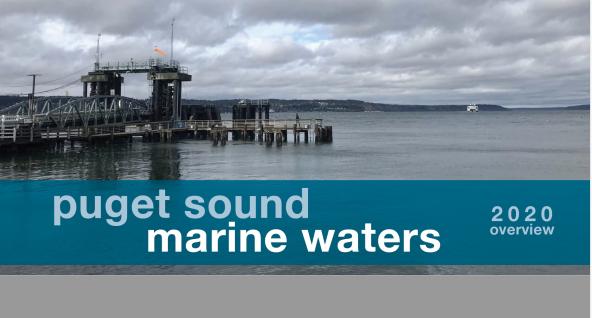While Covid restrictions remain a part of everyday life, a lot has eased since the global quarantines of spring 2020. During that time, the coronavirus effectively shut down scientific fieldwork in Puget Sound, leaving huge gaps in data for most facets of the ecosystem, from orcas to eelgrass.
Despite the lockdowns, a new report from the Puget Sound Ecosystem Monitoring Program offers an assessment of marine conditions during 2020 and paints a surprisingly complete picture of the local environment at that time. This is the tenth year that the group has prepared an annual marine waters overview, and while the environmental conditions measured in 2020 may not have been particularly remarkable — they are described in the report as “somewhat typical in terms of Puget Sound water properties and biota” — the challenges for scientists were extraordinary and historic.
In some cases, during the pandemic, Puget Sound scientists risked their health to monitor endangered species or to conduct research deemed essential by state and federal agencies. Autonomous sampling devices and citizen volunteers also provided much-needed help as many scientists were grounded and research vessels were docked.
Much of this data has been compiled in the annual report, which the authors call “a tribute to the resilience of the scientists and institutions producing it.” Thanks to their efforts and those of dozens of scientists at agencies, tribes and other organizations, the Puget Sound Marine Waters Overview 2020 summarizes what we know about Puget Sound’s marine ecosystem during Covid Year One. The overview examines patterns and trends in numerous categories, including plankton, water quality, climate, and marine life. Technical summaries from the report are also used to inform the Puget Sound Vital Signs, a series of indicators of Puget Sound ecosystem health established by the Puget Sound Partnership.
The following highlights from the report were provided by the Puget Sound Ecosystem Monitoring Program. The Puget Sound Institute assisted with the preparation of the report.
Conditions in Puget Sound were generally warmer, sunnier, and wetter in 2020 but not extreme.
- Coastal deep waters, source waters to the Salish Sea, were cooler than typical as recorded since 2014 and may have been influenced by La Nina conditions. Surface waters returned to near normal, signaling the end of the 2019 marine heat wave.
- Though runoff and precipitation were somewhat above normal, salinity in Puget Sound was generally higher than average, suggesting that the longer period of upwelling of cool and salty waters had the predominant influence. Both Puget Sound’s temperature and salinity conditions during 2020 highlight the strong controlling influence of the coastal ocean on these inland waters
- Seasonal phytoplankton blooms were evident in the Main Basin of Puget Sound, with diatoms predominating as usual in spring and transitioning to flagellates in summer.
- Zooplankton were relatively typical across most of the Sound, but with higher abundance and biomass in northern Puget Sound and Padilla Bay. Species differences can influence the relationship between abundance and biomass. For example, modest abundance of a large oceanic copepod in the north Sound yielded high zooplankton biomass, while record high abundance of a smaller resident copepod in the south Sound resulted in relatively normal biomass.
- Overall, there was a small increase in the number of beaches that met swimming standards in 2020 relative to 2019. The highest fecal bacteria concentrations occurred in September through December, associated with increased rainfall.
No fish kills or strong hypoxia events were reported.
- Dissolved oxygen (DO), affected by phytoplankton and seawater processes, was not particularly high or low in 2020.
- Some seasonal blooms and moderate hypoxia were seen in isolated areas like south Hood Canal, Quartermaster Harbor, and Port Susan.
Ocean acidification (OA) in Puget Sound waters continues as our understanding of patterns grows.
- Annual average atmospheric carbon dioxide (CO2) values over Hood Canal were high relative to globally averaged marine surface air, yet were at the same level as in 2019 rather than showing the expected annual increase, possibly reflecting reduced regional emissions due to COVID-19. West coast wildfires put a definite mark on conditions in September 2020, with reduced sunlight and increased atmospheric CO2 levels on the coast and in Puget Sound.
Biological responses to changing conditions vary – some good news, some bad.
- Zooplankton were relatively typical but with higher abundance and biomass in northern Puget Sound and Padilla Bay.
- Pacific herring spawning biomass was highest since 1984, but driven by only two successful stocks, indicating a loss in diversity of the herring stock portfolio.
- Juvenile Puget Sound-origin Chinook migrating through the San Juan Islands have been eating less forage fish than in 2011-2014.
Seabird abundance and species diversity were typical to low. An encouraging observation is that the rhinoceros auklet breeding effort and reproductive success that, after three consecutive years of anomalously poor conditions had returned to long-term average values in 2019, were stable in 2020.
Next year, the Puget Sound Ecosystem Monitoring Program will begin compiling a summary of the marine conditions of 2021.
